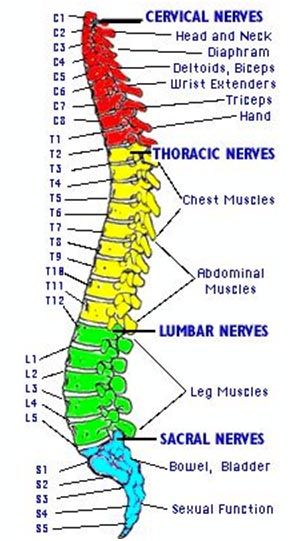Just like Nicolas Cage movies, no two spinal cord injuries are the same, or very good. As we discussed before, somebody with a C-4 level injury will have different function than somebody with a T-10 injury. Even when the same level is injured, there are many variables that determine your functional abilities.
The angle your bone penetrates the spinal cord, the depth of that penetration, the unique alignment of nerves in your spinal cord, and area of impact are a few of the factors affecting your distinctive injury. All of these pieces interact to determine what your new body can and cannot do. Johnny Bag O’Doughnuts with a C-5 injury may have significantly more function than Tony Cheesesandwich who also has a C-5 level injury.
Johnny can transfer into his car on his own, because he has significant triceps function. Tony has zero triceps and needs to use his shoulders to move from his chair to his bed. Johnny, by pure luck, maintained some control of his triceps, only because of the way he was injured.
On the other hand, Tony feels a swelling sensation when he has to urinate where Johnny has no alert to when he needs to go. These are only two examples, there are thousands of different connections that your body may or may not have maintained. The important thing to take away is that you can never completely base your expectations on anybody else.
It is very helpful to group people with similar injury levels together, they will generally have the same physical abilities. But never restrict yourself, always know you can potentially do more, and the only way to find out is to try.
The image to the right shows the expected functional abilities by each level of spinal cord injury. This is not written in stone, but it is a great place to base your expectations. Take a look carefully.
As you can see, each level down the spinal cord grants more control (we will use cervical injuries again for an example because each cervical level has a more distinct 1-to-1 function group). If you have a C-6 injury, the critical thing to understand about this map goes beyond having wrist extenders, but what that means in living your day-to-day life.
On the first level it means you can bend your wrists up. On the second level, in the context of your life, it means you can hook onto doors, tables, your wheelchair, and many other things. This allows you to grab stuff, pull things towards you, pull your body up from different positions, open doors, collapse wheelchairs, and many other activities.
And you can expect to do all of these things based off of that one significant functional ability – wrist extenders. This concept adapts to every level of a spinal cord injury, with each new functional ability gained an entire new group of capabilities opens up. You can expect to be more independent with each lower level of injury (towards your feet).
functional ability gained an entire new group of capabilities opens up. You can expect to be more independent with each lower level of injury (towards your feet).
The best way to understand your new body’s potential is to meet and interact with people sharing your injury level. As I said earlier, no two injuries will be the same, but meeting face-to-face with a person sharing your injury level will show you what to generally expect. Especially if the person is more than five years injured, they know what their body can do and they know how to adapt that function to their day-to-day life.
This injury redefines your physical body, and only you will truly know what is possible. Managing your expectations and pushing yourself to exceed them will allow you to make the most out of your new body.
Video: Levels of Function in Spinal Cord Injury
Takeaway Points:
- Each vertebrae protects a section of the spinal cord that moves a specific part of your body.
- As you extend down the vertebrae column, the sequence moves body downwards, starting with the diaphram, then neck, shoulders, biceps, wrists, etc.
- No two injuries are equal, especially if your injury is incomplete.
Helpful Links:
- Spinal Cord Injury Levels & Classification – SCI Info Pages
- Understanding the Spinal Cord – Shepherd Center
Do you need knowledgeable community support for yourself or a loved one who is in the hospital or just returned home with a spinal cord injury? Our team of peer mentors can help you navigate the resources available to you as well as avoid common pitfalls around fundraising and disability benefits. C4-5 quadriplegic Josh Basile, C7 quadriplegic Jonathan Sigworth, and T6 Paraplegic Rose Dougherty have years of lived experience with SCI and have helped thousands navigate the path to independence during and after rehabilitation. Schedule a FREE video call today by clicking on the following link: https://bit.ly/SPINALpediaNewlyInjured










